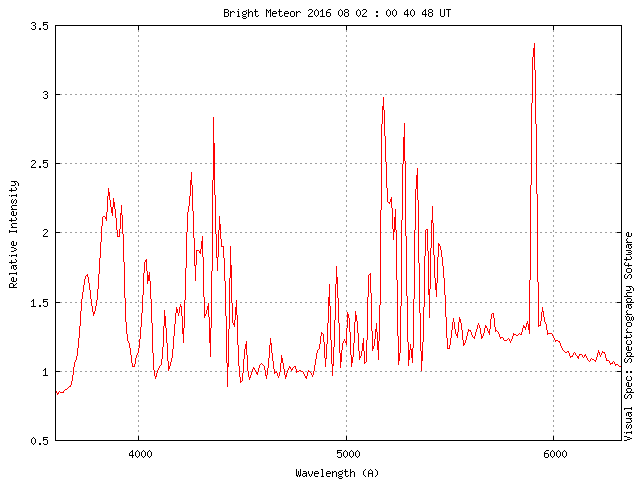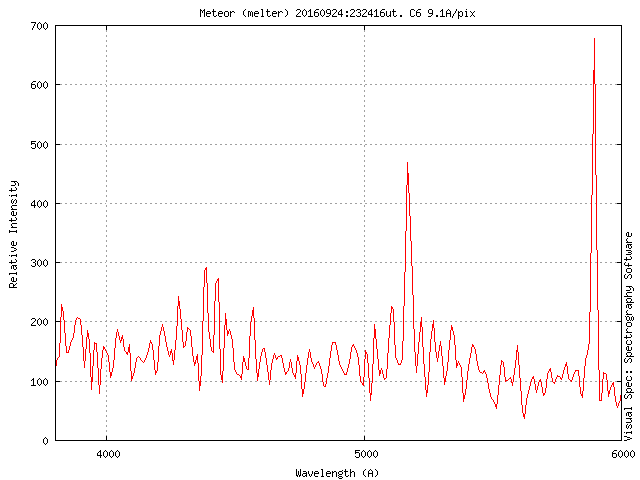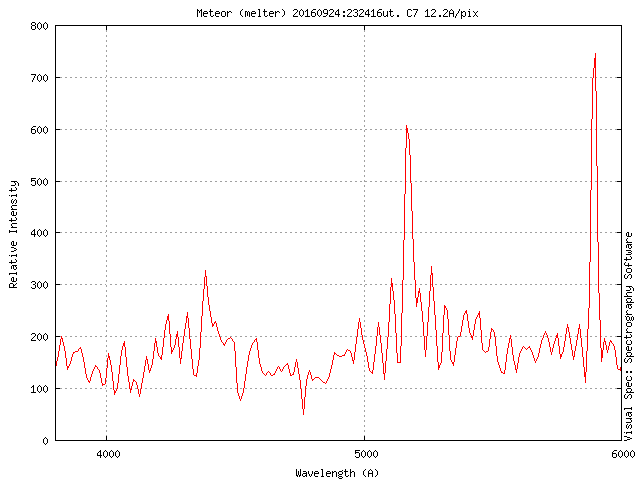- This topic has 51 replies, 6 voices, and was last updated 8 years, 11 months ago by
 Bill Ward.
Bill Ward.
-
AuthorPosts
-
2 August 2016 at 10:24 pm #577448
 Bill WardParticipant
Bill WardParticipantHi,
After the long twilights it was back to the spectro action last night!
Fortune gave me a very bright spectrum this morning. Both good dispersion and good resolution.


Many iron lines with a strong sodium line so very probably a stony iron meteoroid. However doing a instrument flux correction shows the “true” brightness of the blue iron lines.

The video was quite interesting because the sodium line was very prominent on it’s own for a significant proportion of the meteors duration before the other lines lit up.
cheers,
Bill.
3 August 2016 at 10:03 am #577449 Jeremy ShearsParticipant
Jeremy ShearsParticipantImpressive spectrum, Bill. Well done! You should be able to dig out quite of lot of information from that.
Too much to hope that somone else also captured the meteor to allow a triangulation, I suppose?
Good to hear darkeness has returned – looking forward to seeing more meteor spectra in the weeks ahead.
Jeremy
3 August 2016 at 4:43 pm #577450 Bill WardParticipant
Bill WardParticipantHi,
Thanks, Unfortunately the zero order fell outside my fov because David Anderson did catch it also. It was a really nice sporadic.
Here is Davids picture.

It would have been nice, I was very pleased with it for a first order spectrum. The dispersion was almost perfect at ~0.9nm/pix (a rare occurence with meteor spectroscopy!) and the effective resolution was ~1.9nm/pix fwhm on the blue/green irons lines. The multi station, multi technique data is slowly building up, we’ll get plenty more with the additional spectro stations now,
cheers,
Bill.
13 August 2016 at 4:52 pm #577463 Bill WardParticipant
Bill WardParticipantHi,
The Perseids have been a washout both metaphorically and literally. A ton of rain came down on Thursday night.
However ever the optimist I watched the skies closely and after 48 hours of cloud and rain there was a mysterious clearance for around 20 minutes last night. Rain stopped, wind dropped to near zero and the sky cleared. So I deployed my camera rigs as quickly as possible and I managed to capture a few meteors and one spectrum. Unfortunately the spectrum was contaminated by both scattered light and some in frame clouds. However if was well dispersed and showed some really nice detail at the red end.
The direction indicated it was a perseid fireball but the spectrum had the tell-tale emission at 557.7nm typical of high speed meteors. What was interesting about this one was the detail in the atmospheric bands. Perseids are high speed meteors and they carry a lot of energy. This energy is available for excitation as the meteors kinetic energy is transformed into heat.
Slight diversion… in 2002 astronomers at the VLT caught a spectrum by chance using the FORS1 spectrograph. After removing the redshifted lines of the supernova the remaining lines were of the atmospheric emissions of O, O2, N, N2.
As this was a highly accurate instrument the line measurements are invaluable for calibrating meteor spectrum. I thought it would be interesting to compare the results of a multi-million euro instrument against my 500 quid system…

VLT spectrum sections are in black. The modeling done by the astronomers indicates this is the profile of an emission of 4200K at a height of 95km.
As the devil is in the detail if you look closely at the model line (at around 755nm from O2) it is missing from the VLT observation but it is a distinct line in my spectrum. Another cool aspect is the “height” of the lines in the regions marked. Comparing the various scalings shows a very good ratio relation. So it would suggest that my real spectrum matches the modelling quite well. 4200K it is!
Not too terrible at all… 😉
cheers,
Bill.
16 August 2016 at 6:53 pm #577467 Andy WilsonKeymaster
Andy WilsonKeymasterHi Bill,
That is a very interesting comparison between your Perseid spectrum and the VLT meteor. Encouraging that they show a similar continuum and line profiles.
Cheers,
Andy
25 September 2016 at 8:55 pm #577495 Bill WardParticipant
Bill WardParticipantHi All,
Been getting some interesting results recently but the other night I got a spectrum on 3 cameras of the same meteor! Only two were useable and even these were quite noisy. Meteor was maybe mag 0 – -1. (This might be more properly placed on the “Fading meteor” thread but as its about spectra… 😉 )
HOWEVER, this (or these) are the first spectrum I’ve got from a “melting” meteor. This one, like to others just faded out.
The graphs are very similar (as one would expect) but a few differences creep in from different resolution and processing artifacts.
The first graph is from a system with a 830l/mm grating.

…and this from a 600l/mm grating.

Careful review of the video reveals many of the lines are real but it is interetsing to note a large fraction are artifacts. I don’t know if the spectrum actually tell us anything new yet, but it’s a step on the way.
Need to graph the light curve now for the other forum thread…
Cheers,
Bill.
7 October 2016 at 11:02 pm #577516 Bill WardParticipant
Bill WardParticipantHi,
Another interesting capture. Very complex with dispersion ~.5nm/pix. With the efforts of Alex and William of the Nemetode group it’s been tentatively identified as an October Camelopardalid.

The green magnesium line is very broad. Maybe seen as resolved if it hadn’t bloated as the terminal flare saturated.
Some broad similarities between this spectrum and the one in Post #41. Many Fe lines!
cheers,
Bill.
17 November 2016 at 11:55 am #577654 Bill WardParticipant
Bill WardParticipantHad some really nice results recently. Got this nicely detailed spectrum a few nights ago. This one has strong O lines at 557.7nm and 615.6nm as well as several Si+ lines indicating a fairly speedy meteor!

It is worth remembering that the colouration is wavelength stretched and false, the spectrum actually spans from ~370nm to 780nm so, rather sadly, you’d never see it look so nice…
cheers,
Bill.
17 November 2016 at 7:00 pm #577657 Eric WatkinsParticipant
Eric WatkinsParticipantHi Bill,
I’ve been following this thread with a great deal of interest. i is something I’d very much like to get involved with and I’ve been looking at setting up my own station using a Watec 910 HX /RC mono camera (that I could also use for asteroid/star occultation events as and when)
I’d like a little more guidance on camera lenses and diffraction gratings and how to source them and mount them in relation to the camera lens. Maybe you could drop me an email.
Eric
17 November 2016 at 7:02 pm #577658 Eric WatkinsParticipant17 November 2016 at 10:13 pm #577659
Eric WatkinsParticipant17 November 2016 at 10:13 pm #577659 Andy WilsonKeymaster
Andy WilsonKeymasterHi Bill,
That is a fantastic looking spectrum with lots of features in it.
If you are able to convert your meteor spectra to 1D FITS format then you will be able to load them into the new BAA Spectroscopy Database. Let me know if you are interested and if I can be of any assistance.
Cheers,
Andy
5 February 2017 at 3:32 am #577923 Bill WardParticipant
Bill WardParticipantHi Eric,
Appologies for the delay, did I ever reply….? Just checking the forum for the first time in a while. I’m afraid I have been out of the scene for a couple of months due to a horrific multiple fracture of my right arm. Bones sticking out in all directions, it was pretty gruesome! Needed several ops and I’m still in a cast!
However as an alternative source of information immediately the most excellent Nemetode website at
http://www.nemetode.org/analysis%20techniques.htm
have the technical notes here explaining just about everything!
Hope this helps.
Cheers,
Bill.
-
AuthorPosts
- You must be logged in to reply to this topic.

Hi Bill,
I’ve been following this thread with a great deal of interest. i is something I’d very much like to get involved with and I’ve been looking at setting up my own station using a Watec 910 HX /RC mono camera (that I could also use for asteroid/star occultation events as and when)
I’d like a little more guidance on camera lenses and diffraction gratings and how to source them and mount them in relation to the camera lens. Maybe you could drop me an email.
Eric